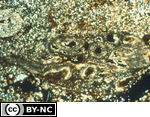Download Image
5.00 MB

ID # 158
Secondary sparitic calcite pseudomorphosing root cellsFrom the Soil Micromorphology Slide Collection
STEM Standard addressed: ESS2E - Biogeology
Appropriate Grade Level(s)
- College-level
- Classroom Lectures
- Laboratory Activities
- Soil Microbiology
Data for 35-mm slide
Description of biological feature: Sparitic calcite fills root cells and micritic calcite is generally precipitated around root exteriors.
Data for the horizon
Horizon sampled: BCkt
Depth sampled: 94-1 10 cm
Physical and chemical data available: Sand = 22%, silt - 58%, clay 20%; pH = 8.2, cac03 200 g kg-I ; OC = 2 g kg -I .
Macromorphological description of horizon: 10 YR 5/6 silt loam; massive structure; 10 YR 4/4 clay coatings; common, fine, prominent 10 YR 8/2 secondary carbonates.
Micromorphological description of horizon: Single-spaced porphyric related distribution pattern. Crystallitic birefringence fabric. Channel microstructure.
Data for thin section
Preparation of sample: Air dry
Impregnating medium: Polyester resin
Thickness of section: 30 µm
Orientation of section: Vertical
Soil Classification
U.S.: Typic Hapludalf
Physiographic position: Upland
Topography and hill slope position: 0-2% summit
Parent material: Late Weichselian loess
Soil climatic data and/or soil water balance: Mean annual temperature 10.5 degrees C; mean annual precipitation 634 mm
Vegetation: Deciduous forest
Description of biological feature: Sparitic calcite fills root cells and micritic calcite is generally precipitated around root exteriors.
Data for the horizon
Horizon sampled: BCkt
Depth sampled: 94-1 10 cm
Physical and chemical data available: Sand = 22%, silt - 58%, clay 20%; pH = 8.2, cac03 200 g kg-I ; OC = 2 g kg -I .
Macromorphological description of horizon: 10 YR 5/6 silt loam; massive structure; 10 YR 4/4 clay coatings; common, fine, prominent 10 YR 8/2 secondary carbonates.
Micromorphological description of horizon: Single-spaced porphyric related distribution pattern. Crystallitic birefringence fabric. Channel microstructure.
Data for thin section
Preparation of sample: Air dry
Impregnating medium: Polyester resin
Thickness of section: 30 µm
Orientation of section: Vertical
Soil Classification
U.S.: Typic Hapludalf
Physiographic position: Upland
Topography and hill slope position: 0-2% summit
Parent material: Late Weichselian loess
Soil climatic data and/or soil water balance: Mean annual temperature 10.5 degrees C; mean annual precipitation 634 mm
Vegetation: Deciduous forest
Method
Frame length: 3500 um
Light mode: Circularly polarized
Light mode: Circularly polarized
References
Thompson M.L., N. Fedoroff and B. Fournier. 1 990. Morphological features related to agriculture and faunal activity in three loess-derived soils in France. Geoderma 46: 329-349.
Source - M. L. Thompson
Soil Science Society of America,1993. A Reference slide collection for soil micro morphology, SSA, Madison, WI.
Source - M. L. Thompson
Soil Science Society of America,1993. A Reference slide collection for soil micro morphology, SSA, Madison, WI.
Peer Review: Yes
Credit this item to: SSSAMedia Date: 1993-01-01
Provided By: (SSSA) Soil Science Society of America
Author(s)/Creator(s)
-
* Soil Science Society of America
SSSA
membership@soils.org
Submitted By: (SSSA) Soil Science Society of America
Keywords
- Biological Features
- BCkt
- micromorphology
- Sparitic Calcite
Comments
Please login to submit a comment.
Log In to your account
Already a member, certified, or existing customer?*
* Cookies must be accepted to log in.
Not sure if you have an account?
Check Your Email
Join Us!
Connect with members and access the information you need.
Learn more.
Ready to Join?
If you have an account, login on the left. Not sure if you have an account or need to create one? Check your email with the link above. We look forward to welcoming you.